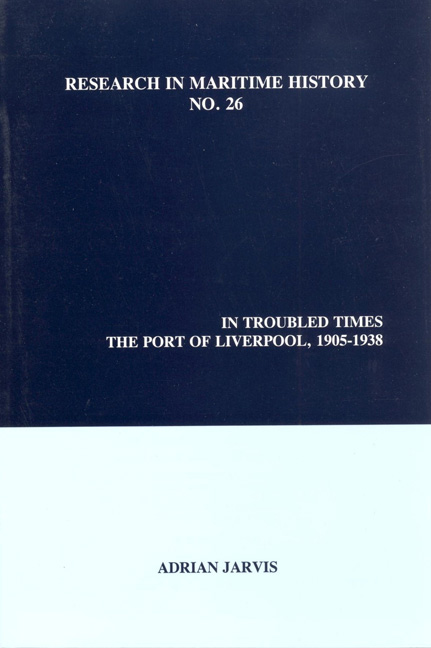Book contents
- Frontmatter
- Table of Contents
- List of Figures
- Foreword and Acknowledgements
- Conversion Factors for Imperial Measurements
- Introduction: The Port of Liverpool in 1905
- Chapter 1 The Port and Its Trade in 1905
- Chapter 2 Gladstone Dock
- Chapter 3 Not Before Time: The Board Keeps its Promise
- Chapter 4 Engineering, Management and Decision-making
- Chapter 5 Making the Customers Happy
- Chapter 6 Sand, Silt and Sewage: The Work of the Board's Dredgers
- Chapter 7 The Provision of Specialist Cargo Facilities
- Chapter 8 Into the Modern World?
- Conclusion: On the Eve of War
- Appendix: Port Efficiency: A Short Methodological Discourse
- A Note on Sources: Abbreviations
- Bibliography
- Index
Introduction: The Port of Liverpool in 1905
- Frontmatter
- Table of Contents
- List of Figures
- Foreword and Acknowledgements
- Conversion Factors for Imperial Measurements
- Introduction: The Port of Liverpool in 1905
- Chapter 1 The Port and Its Trade in 1905
- Chapter 2 Gladstone Dock
- Chapter 3 Not Before Time: The Board Keeps its Promise
- Chapter 4 Engineering, Management and Decision-making
- Chapter 5 Making the Customers Happy
- Chapter 6 Sand, Silt and Sewage: The Work of the Board's Dredgers
- Chapter 7 The Provision of Specialist Cargo Facilities
- Chapter 8 Into the Modern World?
- Conclusion: On the Eve of War
- Appendix: Port Efficiency: A Short Methodological Discourse
- A Note on Sources: Abbreviations
- Bibliography
- Index
Summary
In 1905 Liverpool was still by a wide margin the largest port in the country administered by a single port authority, the Mersey Docks and Harbour Board (MD&HB). It was the second port in the Empire in terms of the value of goods handled and Britain's largest export port. This situation resulted from nearly two centuries of investment in the infrastructure of the port, beginning with the Liverpool Corporation's decision in 1709 to seek an Act of Parliament to enable the construction of what was to be the first commercial wet dock in the world.
This was necessary because, as numerous writers have remarked, any advantage Liverpool might derive from its favourable geographical position was nullified by the hostile and often dangerous nature of its river. Samuel Smiles and his imitators often made such statements as “the task of the engineer is to transform,” by which they meant that what Mother Nature gave with one hand, she might well take away with the other. Liverpool, like Bristol, could only respond to economic stimuli, grow and prosper through the ingenuity of the engineers - and the raising of money to pay for their work. Each time the engineers found a solution, the port's customers altered the question, a situation which remains fundamentally unchanged between 1709 and the present.
The result was a continuum of dock engineering work which might be considered in three categories: repairs and minor improvements; major remodelling of old works; and construction of new works. The first were normally funded from revenue, principally dues on goods and ships, and the last invariably from borrowed capital, with the intermediate category funded either way, according to cost and the state of the port authority's cash flow. Since this led to a continuing growth of debt, the only way to continue modernising while meeting interest payments was through the continuing expansion of trade, which implied an expansion of the physical extent of the port. As a result, by 1905 the water area of the Liverpool docks had risen from the 3.5 acres of the first dock to 336 acres, while across the river at Birkenhead a further 160 acres had been added.
- Type
- Chapter
- Information
- In Troubled TimesThe Port of Liverpool, 1905-1938, pp. 1 - 26Publisher: Liverpool University PressPrint publication year: 2003



